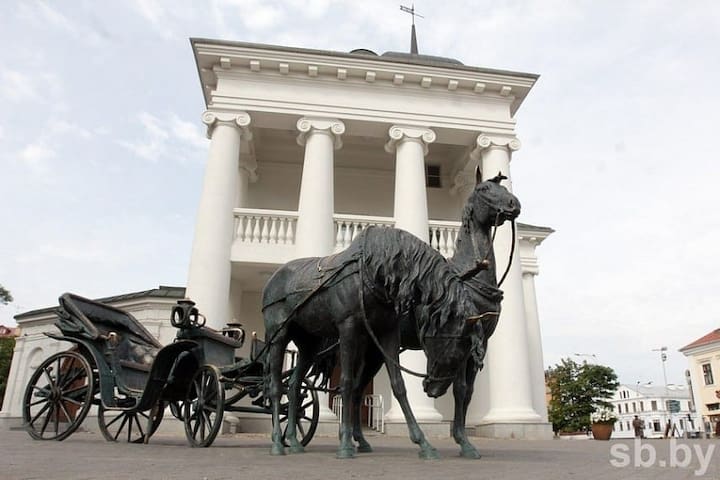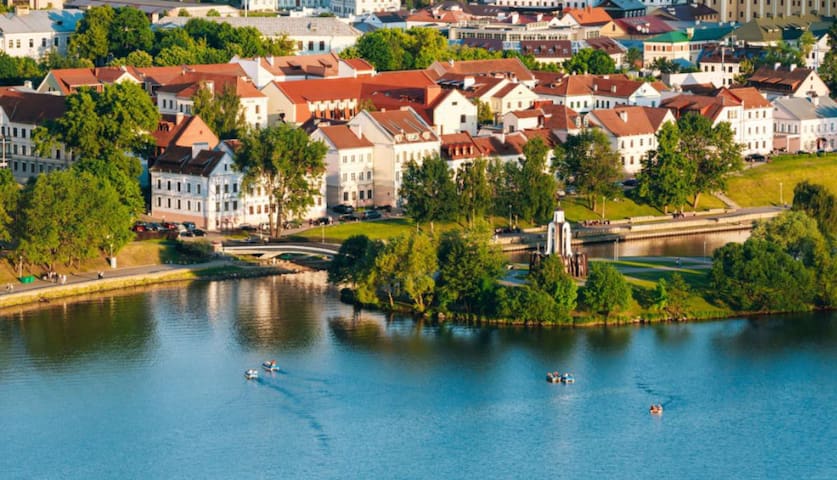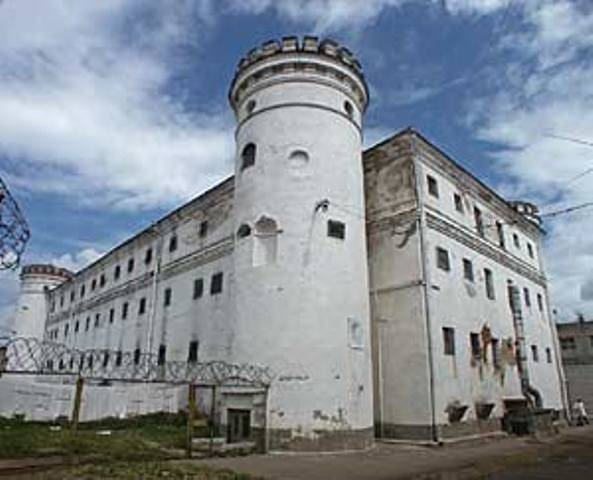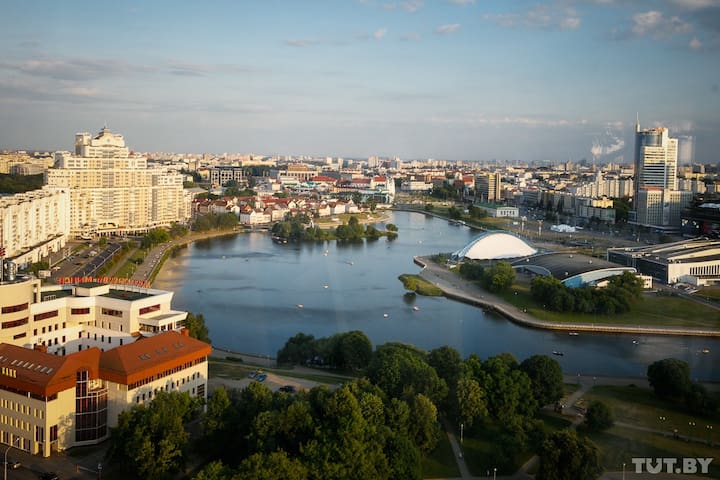Районы
Rakaŭskaje pradmiescie — the historic district of Minsk, located along the ancient road to Rakaŭ. Here was the Uniate Church, Carmelite monastery and the Church of St. Mary Magdalene, Orthodox monastery and the Church of the Holy Apostles Peter and Paul. Pay attention to the building of the former synagogue (Rakovskaya St., 17), built at the end of the eighteenth century in the style of early classicism (according to information from other sources, the Jewish wedding house was located here).
8 íbúar mæla með
Rakovskoye Predmest'ye
Rakaŭskaje pradmiescie — the historic district of Minsk, located along the ancient road to Rakaŭ. Here was the Uniate Church, Carmelite monastery and the Church of St. Mary Magdalene, Orthodox monastery and the Church of the Holy Apostles Peter and Paul. Pay attention to the building of the former synagogue (Rakovskaya St., 17), built at the end of the eighteenth century in the style of early classicism (according to information from other sources, the Jewish wedding house was located here).
Достопримечательности
Rautt garður
7 vulica RevaliucyjnajaInteresting place with bars inside the yard.
Monument to the victims of the Holocaust. During the war, 5 thousand Jews from the Minsk ghetto were shot at this place. In total, about 100 thousand Jews were shot during the war in the Minsk ghetto.
7 íbúar mæla með
Yama Memorial
Central DistrictMonument to the victims of the Holocaust. During the war, 5 thousand Jews from the Minsk ghetto were shot at this place. In total, about 100 thousand Jews were shot during the war in the Minsk ghetto.
Исторические здания Минска сохранились в основном в Верхнем городе. Здесь по соседству располагались мужской и женский монастыри бернардинцев, представлявшие собой целый комплекс сооружений. На возвышении стоит Свято-Духов кафедральный собор — бывший бернардинский костел монастыря, построенный в XVII веке. В 1870 году монастырь стал православным, а собор реконструировали. В 1918 году после прихода большевиков собор был закрыт. Богослужения здесь возобновились в 1943 году, а в 47-м на соборе возвели кресты. С конца XIX века за храмом размещался архив, в монастырских помещениях содержали арестованных повстанцев, а в начале ХХ века открыли торговые ряды. Сейчас торговые ряды уступили место кафе, а в бывшем костеле до наших дней располагается архив. После войны под площадью Свободы обнаружили подземные ходы, ведущие от костелов и монастырей к берегу реки. Спуск в туннель был выложен кирпичом, а вход закрывался на железную дверь. Теперь ходы засыпаны.
The historical buildings of Minsk have been preserved mainly in the Upper Town. Here in the neighborhood were the Bernardine male and female monasteries, which represented a whole complex of structures. On the dais stands the Holy Spirit Cathedral - the former Bernardine church of the monastery, built in the 17th century. In 1870, the monastery became Orthodox, and the cathedral was reconstructed. In 1918, after the arrival of the Bolsheviks, the cathedral was closed. Divine services were resumed in 1943, and in the 47th, crosses were erected at the cathedral. Since the end of the 19th century, an archive was located behind the temple, the monastery premises contained arrested rebels, and at the beginning of the 20th century, shopping arcades were opened. Now the shopping arcade has given way to a cafe, and the archive is located in the former church to this day. After the war, underground passages were discovered under Freedom Square, leading from churches and monasteries to the banks of the river. The descent into the tunnel was bricked, and the entrance was closed on an iron door. Now the moves are filled up.
60 íbúar mæla með
Vierchni Horad
Исторические здания Минска сохранились в основном в Верхнем городе. Здесь по соседству располагались мужской и женский монастыри бернардинцев, представлявшие собой целый комплекс сооружений. На возвышении стоит Свято-Духов кафедральный собор — бывший бернардинский костел монастыря, построенный в XVII веке. В 1870 году монастырь стал православным, а собор реконструировали. В 1918 году после прихода большевиков собор был закрыт. Богослужения здесь возобновились в 1943 году, а в 47-м на соборе возвели кресты. С конца XIX века за храмом размещался архив, в монастырских помещениях содержали арестованных повстанцев, а в начале ХХ века открыли торговые ряды. Сейчас торговые ряды уступили место кафе, а в бывшем костеле до наших дней располагается архив. После войны под площадью Свободы обнаружили подземные ходы, ведущие от костелов и монастырей к берегу реки. Спуск в туннель был выложен кирпичом, а вход закрывался на железную дверь. Теперь ходы засыпаны.
The historical buildings of Minsk have been preserved mainly in the Upper Town. Here in the neighborhood were the Bernardine male and female monasteries, which represented a whole complex of structures. On the dais stands the Holy Spirit Cathedral - the former Bernardine church of the monastery, built in the 17th century. In 1870, the monastery became Orthodox, and the cathedral was reconstructed. In 1918, after the arrival of the Bolsheviks, the cathedral was closed. Divine services were resumed in 1943, and in the 47th, crosses were erected at the cathedral. Since the end of the 19th century, an archive was located behind the temple, the monastery premises contained arrested rebels, and at the beginning of the 20th century, shopping arcades were opened. Now the shopping arcade has given way to a cafe, and the archive is located in the former church to this day. After the war, underground passages were discovered under Freedom Square, leading from churches and monasteries to the banks of the river. The descent into the tunnel was bricked, and the entrance was closed on an iron door. Now the moves are filled up.
Первая минская ратуша была построена в 1600 году и обладала единственными в городе часами. Находится на Площади Свободы. Раньше площадь называлась Высокий рынок. Площадь возникла в начале XVI века как административный, торговый и культурный центр города.
The first Minsk city hall was built in 1600 and possessed the only watch in the city. Located on Freedom Square. The square used to be called High Market. The square arose at the beginning of the XVI century as the administrative, commercial and cultural center of the city.
60 íbúar mæla með
Minsk City Hall
2а plošča SvabodyПервая минская ратуша была построена в 1600 году и обладала единственными в городе часами. Находится на Площади Свободы. Раньше площадь называлась Высокий рынок. Площадь возникла в начале XVI века как административный, торговый и культурный центр города.
The first Minsk city hall was built in 1600 and possessed the only watch in the city. Located on Freedom Square. The square used to be called High Market. The square arose at the beginning of the XVI century as the administrative, commercial and cultural center of the city.
С моста на Немиге видна возвышенность, с которой начался Минск. Минское замчище располагалось на слиянии рек Немига и Свислочь в ХI-ХVI веках. Сейчас на этом месте магазин «Алеся», один из входов на станцию метро «Немига» и здание спортивного общества «Трудовые резервы». Раньше эта территория была окружена 10-метровым валом, за которым текла река. Само замчище было деревянным, и после пожара в середине XVI века городской центр перенесли на современную территорию Верхнего города. На территории крепости, которую прозвали Нижним городом, с тех пор жили в основном евреи и шла бойкая торговля, здесь же был главный рынок города.
From the bridge on Nemiga you can see the hill with which Minsk began. Minsk Castle was located at the confluence of the Nemiga and Svisloch rivers in the 11th-16th centuries. Now at this place is the Alesia store, one of the entrances to the Nemiga metro station and the building of the labor reserves Sports Reserves society. Previously, this territory was surrounded by a 10-meter rampart, beyond which the river flowed. The castle itself was wooden, and after a fire in the middle of the 16th century, the city center was transferred to the modern territory of the Upper City. Since then, mainly Jews were living on the territory of the fortress, which was called the Lower City, and there was a lively trade, here was the main market of the city.
Zamčyšča
С моста на Немиге видна возвышенность, с которой начался Минск. Минское замчище располагалось на слиянии рек Немига и Свислочь в ХI-ХVI веках. Сейчас на этом месте магазин «Алеся», один из входов на станцию метро «Немига» и здание спортивного общества «Трудовые резервы». Раньше эта территория была окружена 10-метровым валом, за которым текла река. Само замчище было деревянным, и после пожара в середине XVI века городской центр перенесли на современную территорию Верхнего города. На территории крепости, которую прозвали Нижним городом, с тех пор жили в основном евреи и шла бойкая торговля, здесь же был главный рынок города.
From the bridge on Nemiga you can see the hill with which Minsk began. Minsk Castle was located at the confluence of the Nemiga and Svisloch rivers in the 11th-16th centuries. Now at this place is the Alesia store, one of the entrances to the Nemiga metro station and the building of the labor reserves Sports Reserves society. Previously, this territory was surrounded by a 10-meter rampart, beyond which the river flowed. The castle itself was wooden, and after a fire in the middle of the 16th century, the city center was transferred to the modern territory of the Upper City. Since then, mainly Jews were living on the territory of the fortress, which was called the Lower City, and there was a lively trade, here was the main market of the city.
Сегодняшнее Троицкое предместье было заселено одним из первых. Здесь сходились торговые пути окрестных городов. Это было самое большое предместье Минска, сейчас от него остался один квартал. В здании нынешнего Музея истории белорусской литературы (Богдановича, 13) раньше была обувная фабрика, на которой трудились 40 рабочих.
Сегодняшнее Троицкое предместье было заселено одним из первых. Здесь сходились торговые пути окрестных городов. Это было самое большое предместье Минска, сейчас от него остался один квартал. В здании нынешнего Музея истории белорусской литературы (Богдановича, 13) раньше была обувная фабрика, на которой трудились 40 рабочих.
Today's Trinity suburb was one of the first to be populated. The trade routes of the surrounding cities converged here. This was the largest suburb of Minsk, now it remains one block. The building of the current Museum of the History of Belarusian Literature (13 Bogdanovich) used to have a shoe factory with 40 workers.
11 íbúar mæla með
Trinity Suburb
10а vulica StaražoŭskajaСегодняшнее Троицкое предместье было заселено одним из первых. Здесь сходились торговые пути окрестных городов. Это было самое большое предместье Минска, сейчас от него остался один квартал. В здании нынешнего Музея истории белорусской литературы (Богдановича, 13) раньше была обувная фабрика, на которой трудились 40 рабочих.
Сегодняшнее Троицкое предместье было заселено одним из первых. Здесь сходились торговые пути окрестных городов. Это было самое большое предместье Минска, сейчас от него остался один квартал. В здании нынешнего Музея истории белорусской литературы (Богдановича, 13) раньше была обувная фабрика, на которой трудились 40 рабочих.
Today's Trinity suburb was one of the first to be populated. The trade routes of the surrounding cities converged here. This was the largest suburb of Minsk, now it remains one block. The building of the current Museum of the History of Belarusian Literature (13 Bogdanovich) used to have a shoe factory with 40 workers.
Первая аптека в городе была открыта в ХVII веке. В то время разрешалось открыть аптеку только по разрешению польского короля. К середине ХIХ века их было уже четыре. Старинная аптека сейчас сохранилась на пересечении улиц Богдановича и Сторожевской, здесь можно увидеть раритетные фармацевтические книги.
The first pharmacy in the city was opened in the 17th century. At that time it was allowed to open a pharmacy only with the permission of the Polish king. By the middle of the nineteenth century there were already four. An ancient pharmacy has now been preserved at the intersection of Bogdanovich and Storozhevskaya streets, here you can see rare pharmaceutical books.
Ulitsa Storozhovskaya 3
3 Ulitsa StorozhovskayaПервая аптека в городе была открыта в ХVII веке. В то время разрешалось открыть аптеку только по разрешению польского короля. К середине ХIХ века их было уже четыре. Старинная аптека сейчас сохранилась на пересечении улиц Богдановича и Сторожевской, здесь можно увидеть раритетные фармацевтические книги.
The first pharmacy in the city was opened in the 17th century. At that time it was allowed to open a pharmacy only with the permission of the Polish king. By the middle of the nineteenth century there were already four. An ancient pharmacy has now been preserved at the intersection of Bogdanovich and Storozhevskaya streets, here you can see rare pharmaceutical books.
Самое тусовочное место города
и главная барная улица столицы, где жизнь бьет ключом круглые сутки.
The most party place in the city
and the main bar street of the capital, where life is in full swing around the clock.
Ulitsa Zybitskaya 3
3 vulica ZybickajaСамое тусовочное место города
и главная барная улица столицы, где жизнь бьет ключом круглые сутки.
The most party place in the city
and the main bar street of the capital, where life is in full swing around the clock.
Острог построен в начале 19 века.
Среди узников был известный белорусский писатель Винцент Дунин-Марцинкевич и его дочь Камила, осужденные за распространение революционных листовок и активную поддержку восстания. Кстати, именно в тюремных стенах у писателя родился замысел главного своего произведения — романа «Пинская шляхта».
Сегодня здание знаменитого Пищаловского замка в центре Минска требует капитального ремонта. В апреле 2008 года обвалилась западная башня замка. Что будет с «Володаркой», пока не известно. Возможно, здесь будет создан музей. В мире существует немало примеров, когда в бывших тюрьмах создают культурно-развлекательные объекты. Да и для минчан будет гораздо более приятным соседство с музеем, чем с СИЗО.
The prison was built in the early 19th century.
Among the prisoners was the famous Belarusian writer Vincent Dunin-Martsinkevich and his daughter Kamila, convicted of distributing revolutionary leaflets and actively supporting the uprising. By the way, it was in the prison walls that the writer born the idea of his main work - the novel “Pinsk Gentry”.
Today the building of the famous Pishchalovsky castle in the center of Minsk requires major repairs. In April 2008, the western tower of the castle collapsed. What will happen to Volodarka is not yet known. Perhaps a museum will be created here. There are many examples in the world when cultural and entertainment facilities are created in former prisons. And for Minskers it will be much more pleasant neighborhood with a museum than with a pre-trial detention center.
vulica Valadarskaha 2
2 vulica ValadarskahaОстрог построен в начале 19 века.
Среди узников был известный белорусский писатель Винцент Дунин-Марцинкевич и его дочь Камила, осужденные за распространение революционных листовок и активную поддержку восстания. Кстати, именно в тюремных стенах у писателя родился замысел главного своего произведения — романа «Пинская шляхта».
Сегодня здание знаменитого Пищаловского замка в центре Минска требует капитального ремонта. В апреле 2008 года обвалилась западная башня замка. Что будет с «Володаркой», пока не известно. Возможно, здесь будет создан музей. В мире существует немало примеров, когда в бывших тюрьмах создают культурно-развлекательные объекты. Да и для минчан будет гораздо более приятным соседство с музеем, чем с СИЗО.
The prison was built in the early 19th century.
Among the prisoners was the famous Belarusian writer Vincent Dunin-Martsinkevich and his daughter Kamila, convicted of distributing revolutionary leaflets and actively supporting the uprising. By the way, it was in the prison walls that the writer born the idea of his main work - the novel “Pinsk Gentry”.
Today the building of the famous Pishchalovsky castle in the center of Minsk requires major repairs. In April 2008, the western tower of the castle collapsed. What will happen to Volodarka is not yet known. Perhaps a museum will be created here. There are many examples in the world when cultural and entertainment facilities are created in former prisons. And for Minskers it will be much more pleasant neighborhood with a museum than with a pre-trial detention center.
На улице Володарского раньше находилась женская гимназия, ремесленническое училище, доходные дома и хоральная синагога. После революции ее закрыли и открыли там Дом культуры, потом кинотеатр. После изменения фасада здесь расположился Русский драматический театр имени Горького. В 1925—1927 здесь на сцене выступал Маяковский.
vulica Valadarskaha
vulica ValadarskahaНа улице Володарского раньше находилась женская гимназия, ремесленническое училище, доходные дома и хоральная синагога. После революции ее закрыли и открыли там Дом культуры, потом кинотеатр. После изменения фасада здесь расположился Русский драматический театр имени Горького. В 1925—1927 здесь на сцене выступал Маяковский.
Белорусские ремесленники продают магниты, посуду, вышиванки, соломенные шляпы и пр. в галерее «Славутасць» в Троицком предместье.
Галерея ремесел «Славутасць»
Адрес1: Богдановича, 21, 2й этаж
Адрес2: Троицкая набережная, 6
Телефон: +375 17 334-49-85
Телефон: +375 17 334-49-79
Время работы:
Будние дни: с 10.00 до 19.00
Суббота, Воскресенье: с 10.00 до 17.00
Галерея Славутасць
21 vulica Maksima BahdanovičaБелорусские ремесленники продают магниты, посуду, вышиванки, соломенные шляпы и пр. в галерее «Славутасць» в Троицком предместье.
Галерея ремесел «Славутасць»
Адрес1: Богдановича, 21, 2й этаж
Адрес2: Троицкая набережная, 6
Телефон: +375 17 334-49-85
Телефон: +375 17 334-49-79
Время работы:
Будние дни: с 10.00 до 19.00
Суббота, Воскресенье: с 10.00 до 17.00
Гастрономия
Table With View! Places to observe Minsk from above.
Where: Storozhevskaya str., 15 (22 floor)
When: from 12.00 am to 00.00 pm, from 12.00 am to 02.00 am on Fridays and Saturdays
Price: cappuccino ~5 BYN ($2,5), a teapot ~3,5 BYN ($1,75)
It’s better to call before a visit, because the restaurant is often closed for special services. Dress code is also highly recommended.
Ulitsa Storozhovskaya 15
15 Ulitsa StorozhovskayaTable With View! Places to observe Minsk from above.
Where: Storozhevskaya str., 15 (22 floor)
When: from 12.00 am to 00.00 pm, from 12.00 am to 02.00 am on Fridays and Saturdays
Price: cappuccino ~5 BYN ($2,5), a teapot ~3,5 BYN ($1,75)
It’s better to call before a visit, because the restaurant is often closed for special services. Dress code is also highly recommended.
The viewing platform allows you to sightsee the main tourist attractions: Trinity Suburb, Upper Town, Island of Courage and Sorrow (Island of Tears), as well as new business center buildings.
Where: Pobediteley Ave., 9 (7 floor)
When: from 12.00 am to 23.00 pm, until 24.00 pm on Fridays and Saturdays
Price: cappuccino – 6 BYN ($3), a teapot – 7 BYN ($3,5)
If you want to try something cheaper – drop at the food court with a summer terrace at the shopping center Galleria Minsk (6 floor). Dress code isn’t obligatory, but the beach option is not welcome.
Prospekte Pobeditelei 9
9 Praspiekt PieramožcaŭThe viewing platform allows you to sightsee the main tourist attractions: Trinity Suburb, Upper Town, Island of Courage and Sorrow (Island of Tears), as well as new business center buildings.
Where: Pobediteley Ave., 9 (7 floor)
When: from 12.00 am to 23.00 pm, until 24.00 pm on Fridays and Saturdays
Price: cappuccino – 6 BYN ($3), a teapot – 7 BYN ($3,5)
If you want to try something cheaper – drop at the food court with a summer terrace at the shopping center Galleria Minsk (6 floor). Dress code isn’t obligatory, but the beach option is not welcome.
Белорусская национальная кухня.
Этот большой ресторан находится прямо напротив «Талакі» (и ему уже 20 лет, представляете?), и главная достопримечательность тут – шесть сортов крафтового пива, которое делают прямо на месте. Из еды подают и традиционные блюда национальной кухни, и классику европейской. Посетители хвалят запеченную свиную рульку, но это скорее немецкая история. Супы можно пробовать по 6,90 руб., кроме ухи из осетрины (10,50 руб.). Есть запеченные свиные уши за 4 руб., больше 1/2 кг колдунов обойдутся почти в 20 руб. Драники в трех вариациях – к мачанке (14,50 руб.), с лисичками (12,50 руб.) и со сметаной (8,50 руб.). Еда вкусная, но не восхитительная – за ушами не трещало.
Заведение работает после полуночи, есть залы для курящих, аквариум с рыбами на съедение и живая музыка ежедневно после 20:00. Владельцам «Раковского Бровара», кстати, принадлежит еще и кафе «У Франциска».
Belorussian national cuisine.
This large restaurant is located directly opposite Talakі (and it’s already 20 years old, can you imagine?), And the main attraction here is six sorts of craft beer, which are made right on the spot. The food serves both traditional dishes of national cuisine and European classics. Visitors praise the baked pork shank, but this is more of a German story. Soups can be tasted at 6.90 rubles, except sturgeon fish soup (10.50 rubles). There are baked pork ears for 4 rubles., More than 1/2 kg of sorcerers will cost almost 20 rubles. Draniki in three variations - to the machanka (14.50 rubles), with chanterelles (12.50 rubles) and sour cream (8.50 rubles). The food is tasty, but not delicious - it did not pop behind the ears.
The facility is open after midnight, there are smoking rooms, an aquarium with fish to eat and live music every day after 20:00. The owners of Rakovsky Brovar, by the way, also own the cafe “At Francis”.
42 íbúar mæla með
Rakovskiy Brovar
10 vulica ViciebskajaБелорусская национальная кухня.
Этот большой ресторан находится прямо напротив «Талакі» (и ему уже 20 лет, представляете?), и главная достопримечательность тут – шесть сортов крафтового пива, которое делают прямо на месте. Из еды подают и традиционные блюда национальной кухни, и классику европейской. Посетители хвалят запеченную свиную рульку, но это скорее немецкая история. Супы можно пробовать по 6,90 руб., кроме ухи из осетрины (10,50 руб.). Есть запеченные свиные уши за 4 руб., больше 1/2 кг колдунов обойдутся почти в 20 руб. Драники в трех вариациях – к мачанке (14,50 руб.), с лисичками (12,50 руб.) и со сметаной (8,50 руб.). Еда вкусная, но не восхитительная – за ушами не трещало.
Заведение работает после полуночи, есть залы для курящих, аквариум с рыбами на съедение и живая музыка ежедневно после 20:00. Владельцам «Раковского Бровара», кстати, принадлежит еще и кафе «У Франциска».
Belorussian national cuisine.
This large restaurant is located directly opposite Talakі (and it’s already 20 years old, can you imagine?), And the main attraction here is six sorts of craft beer, which are made right on the spot. The food serves both traditional dishes of national cuisine and European classics. Visitors praise the baked pork shank, but this is more of a German story. Soups can be tasted at 6.90 rubles, except sturgeon fish soup (10.50 rubles). There are baked pork ears for 4 rubles., More than 1/2 kg of sorcerers will cost almost 20 rubles. Draniki in three variations - to the machanka (14.50 rubles), with chanterelles (12.50 rubles) and sour cream (8.50 rubles). The food is tasty, but not delicious - it did not pop behind the ears.
The facility is open after midnight, there are smoking rooms, an aquarium with fish to eat and live music every day after 20:00. The owners of Rakovsky Brovar, by the way, also own the cafe “At Francis”.










